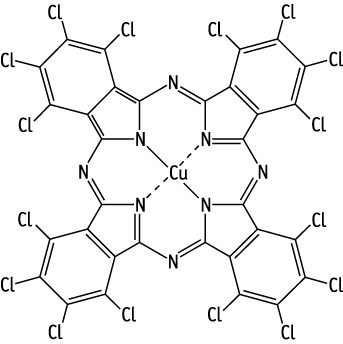

Pigment green No.7 was studied for oral toxicity in rats of both sexes in a single dose toxicity test at doses of 0 and 2000 mg/kg. The single dose toxicity test revealed an LD50 value of more than 2000 mg/kg for both sexes.
Pigment green No.7 was studied for oral toxicity in rats in a 28-day repeated dose toxicity test at doses of 0, 100, 300 and 1000 mg/kg. No effects of pigment green No.7 were detected with any observations, measurements or examination in each sex. No deaths occurred in either sex.
The NOEL for repeat dose toxicity is considered to be 1000 mg/kg/day for both sexes.
Pigment green No.7 was not mutagenic in Salmonella typhimurium TA100, TA1535, TA98, TA1537 and Escherichia coli WP2 uvrA, with or without an exogenous metabolic activation system.
Pigment green No.7 did not induce structural chromosomal aberrations or polyploidy in CHL/IU cells with or without exogenous metabolic activation.
| Purity | : | 99.1 wt% |
| Test species/strain | : | Rat/Crj:CD(SD) |
| Test method | : | OECD Test Guideline 401 |
| 。。Route | : | Oral(gavage) |
| 。。Doses | : | 0, 2000 mg/kg |
| 。。Number of animals/group | : | Males, 5; females, 5 |
| 。。Vehicle | : | Corn oil |
| GLP | : | Yes |
。。Test results:
The LD50 values were estimated to be more than 2000 mg/kg for both sexes.
| Purity | : | 99.1 % |
| Test species/strain | : | Rats/Crj:CD(SD)IGS |
| Test method |
: |
Guideline for 28-Day Repeated Dose Toxicity Test in Mammalian Species (Chemical Substances Control Law of Japan) |
| 。。Route | : | Oral |
| 。。Doses | : | 0(vehicle), 100, 300, 1000 mg/kg/day |
| 。。Number of animals/group | : | Males, 5; females, 5 |
| 。。Vehicle | : | Corn oil |
| 。。Administration period | : | Males and females, 28 days |
| 。。Terminal kill | : | Males and females, days 29 and 43 |
| GLP | : | Yes |
。。Test results:
The NOEL for repeat dose toxicity is considered to be 1000 mg/kg/day for both sexes.
| Purity | : | 99.1 % |
| Test species/strain | : | Salmonella typhimurium TA100, TA1535, TA98, TA1537, Escherichia coli WP2 uvrA |
| Test method |
: |
Guidelines for Screening Mutagenicity Testing of Chemicals(Chemical Substances Control Law of Japan) and OECD Test Guideline 471 |
| 。。Procedures | : | Pre-incubation method |
| 。。Solvent | : | DMSO |
| 。。Positive controls |
: |
-S9 mix; 2-(2-Furyl)-3-(5-nitro-2-furyl)acrylamide (TA100, TA98), Sodium azide (TA1535), 9-Aminoacridine (TA1537) and N-Ethyl-N'-nitro-N-nitrosoguanidine (WP2 uvrA) +S9 mix; 2-Aminoanthracene(all strains) |
| 。。Doses |
: |
-S9 mix; 9.77, 19.5, 39.1, 78.1, 156, 313 and 625 ヲフg/plate(TA100, TA1535, TA98 and TA1537) -S9 mix; 313, 625, 1250, 2500 and 5000 ヲフg/plate(WP2 uvrA) +S9 mix; 156, 313, 625, 1250, 2500 and 5000 ヲフg/plate (TA100, TA1535, TA98 and TA1537) +S9 mix; 313, 625, 1250, 2500 and 5000 ヲフg/plate(WP2 uvrA) |
| 。。S9 | : | Rat liver, induced with phenobarbital and 5,6-benzoflavone |
| 。。Plates/test | : | 3 |
| 。。Number of replicates | : | 2 |
| GLP | : | Yes |
。。Test results:
Genetic effects:
Salmonella typhimurium TA100, TA1535, TA98 and TA1537
| + | ? | - | |
| Without metabolic activation: | [ ] | [ ] | [*] |
| With metabolic activation: | [ ] | [ ] | [*] |
Escherichia coli WP2 uvrA
| + | ? | - | |
| Without metabolic activation: | [ ] | [ ] | [*] |
| With metabolic activation: | [ ] | [ ] | [*] |
| Purity | : | 99.1 % |
| Type of cell used | : | Chinese hamster CHL/IU cells |
| Test method |
: |
Guidelines for Screening Mutagenicity Testing of Chemicals(Chemical Substances Control Law of Japan) and OECD Test Guideline 473 |
| 。。Solvent | : | Dimethylsulfoxide |
| 。。Positive controls |
: |
-S9 mix; Mitomycin C +S9 mix; Benzo[a]pyrene |
| 。。Doses |
: |
-S9 mix(6 hr short-term treatment); 0, 125, 250, 500 ヲフg/mL +S9 mix(6 hr short-term treatment); 0, 125, 250, 500 ヲフg/mL -S9 mix(24 hr continuous treatment); 0, 125, 250, 500 ヲフg/mL |
| 。。S9 | : | Rat liver, induced with phenobarbital and 5,6-benzoflavone |
| 。。Plates/test | : | 2 |
| GLP | : | Yes |
。。Test results:
Genotoxic effects:
| clastogenicity | polyploidy | |||||
| + | ? | - | + | ? | - | |
| Without metabolic activation: | [ ] | [ ] | [*] | [ ] | [ ] | [*] |
| With metabolic activation: | [ ] | [ ] | [*] | [ ] | [ ] | [*] |
| 1) |
The tests were performed by the Biosafety Research Center, Foods, Drugs and Pesticides(An-pyo Center), Japan, 582-2 Arahama, Shioshinden, Fukude-cho, Iwata-gun, Shizuoka, 437-1213, Japan. Tel +81-538-58-1266 Fax +81-538-58-1393 |
| 2) |
The tests were performed by the Mitsubishi Chemical Safety Institute Ltd., 14 Sunayama, Hasaki-machi, Kashima-gun, Ibaraki 314-0255, Japan. Tel +81-479-46-2871 Fax +81-479-46-2874 |